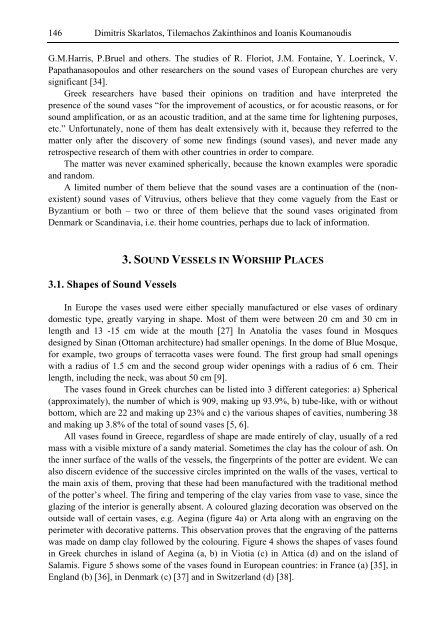Developments in Ceramic Materials Research
Developments in Ceramic Materials Research
Developments in Ceramic Materials Research
You also want an ePaper? Increase the reach of your titles
YUMPU automatically turns print PDFs into web optimized ePapers that Google loves.
146<br />
Dimitris Skarlatos, Tilemachos Zak<strong>in</strong>th<strong>in</strong>os and Ioanis Koumanoudis<br />
G.M.Harris, P.Bruel and others. The studies of R. Floriot, J.M. Fonta<strong>in</strong>e, Y. Loer<strong>in</strong>ck, V.<br />
Papathanasopoulos and other researchers on the sound vases of European churches are very<br />
significant [34].<br />
Greek researchers have based their op<strong>in</strong>ions on tradition and have <strong>in</strong>terpreted the<br />
presence of the sound vases “for the improvement of acoustics, or for acoustic reasons, or for<br />
sound amplification, or as an acoustic tradition, and at the same time for lighten<strong>in</strong>g purposes,<br />
etc.” Unfortunately, none of them has dealt extensively with it, because they referred to the<br />
matter only after the discovery of some new f<strong>in</strong>d<strong>in</strong>gs (sound vases), and never made any<br />
retrospective research of them with other countries <strong>in</strong> order to compare.<br />
The matter was never exam<strong>in</strong>ed spherically, because the known examples were sporadic<br />
and random.<br />
A limited number of them believe that the sound vases are a cont<strong>in</strong>uation of the (nonexistent)<br />
sound vases of Vitruvius, others believe that they come vaguely from the East or<br />
Byzantium or both – two or three of them believe that the sound vases orig<strong>in</strong>ated from<br />
Denmark or Scand<strong>in</strong>avia, i.e. their home countries, perhaps due to lack of <strong>in</strong>formation.<br />
3.1. Shapes of Sound Vessels<br />
3. SOUND VESSELS IN WORSHIP PLACES<br />
In Europe the vases used were either specially manufactured or else vases of ord<strong>in</strong>ary<br />
domestic type, greatly vary<strong>in</strong>g <strong>in</strong> shape. Most of them were between 20 cm and 30 cm <strong>in</strong><br />
length and 13 -15 cm wide at the mouth [27] In Anatolia the vases found <strong>in</strong> Mosques<br />
designed by S<strong>in</strong>an (Ottoman architecture) had smaller open<strong>in</strong>gs. In the dome of Blue Mosque,<br />
for example, two groups of terracotta vases were found. The first group had small open<strong>in</strong>gs<br />
with a radius of 1.5 cm and the second group wider open<strong>in</strong>gs with a radius of 6 cm. Their<br />
length, <strong>in</strong>clud<strong>in</strong>g the neck, was about 50 cm [9].<br />
The vases found <strong>in</strong> Greek churches can be listed <strong>in</strong>to 3 different categories: a) Spherical<br />
(approximately), the number of which is 909, mak<strong>in</strong>g up 93.9%, b) tube-like, with or without<br />
bottom, which are 22 and mak<strong>in</strong>g up 23% and c) the various shapes of cavities, number<strong>in</strong>g 38<br />
and mak<strong>in</strong>g up 3.8% of the total of sound vases [5, 6].<br />
All vases found <strong>in</strong> Greece, regardless of shape are made entirely of clay, usually of a red<br />
mass with a visible mixture of a sandy material. Sometimes the clay has the colour of ash. On<br />
the <strong>in</strong>ner surface of the walls of the vessels, the f<strong>in</strong>gerpr<strong>in</strong>ts of the potter are evident. We can<br />
also discern evidence of the successive circles impr<strong>in</strong>ted on the walls of the vases, vertical to<br />
the ma<strong>in</strong> axis of them, prov<strong>in</strong>g that these had been manufactured with the traditional method<br />
of the potter’s wheel. The fir<strong>in</strong>g and temper<strong>in</strong>g of the clay varies from vase to vase, s<strong>in</strong>ce the<br />
glaz<strong>in</strong>g of the <strong>in</strong>terior is generally absent. A coloured glaz<strong>in</strong>g decoration was observed on the<br />
outside wall of certa<strong>in</strong> vases, e.g. Aeg<strong>in</strong>a (figure 4a) or Arta along with an engrav<strong>in</strong>g on the<br />
perimeter with decorative patterns. This observation proves that the engrav<strong>in</strong>g of the patterns<br />
was made on damp clay followed by the colour<strong>in</strong>g. Figure 4 shows the shapes of vases found<br />
<strong>in</strong> Greek churches <strong>in</strong> island of Aeg<strong>in</strong>a (a, b) <strong>in</strong> Viotia (c) <strong>in</strong> Attica (d) and on the island of<br />
Salamis. Figure 5 shows some of the vases found <strong>in</strong> European countries: <strong>in</strong> France (a) [35], <strong>in</strong><br />
England (b) [36], <strong>in</strong> Denmark (c) [37] and <strong>in</strong> Switzerland (d) [38].
















